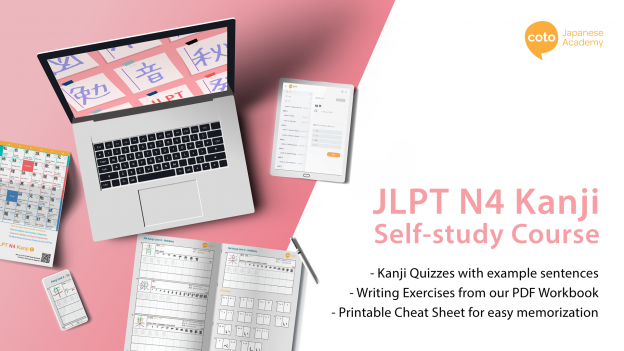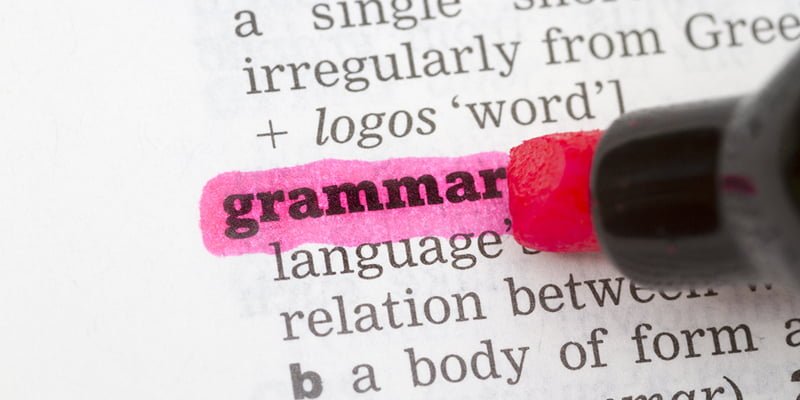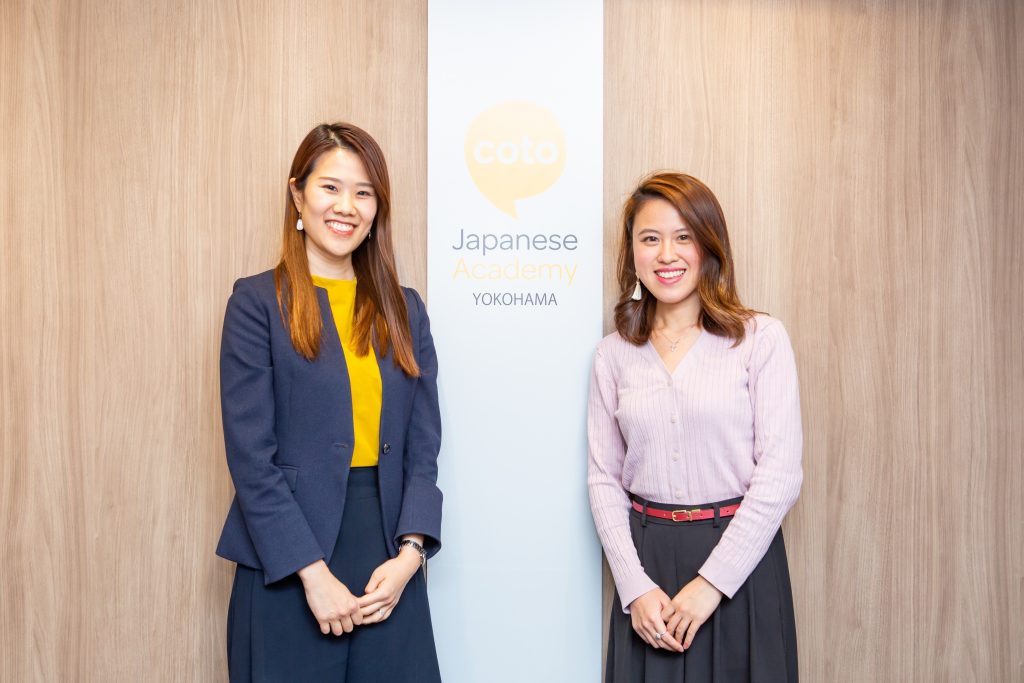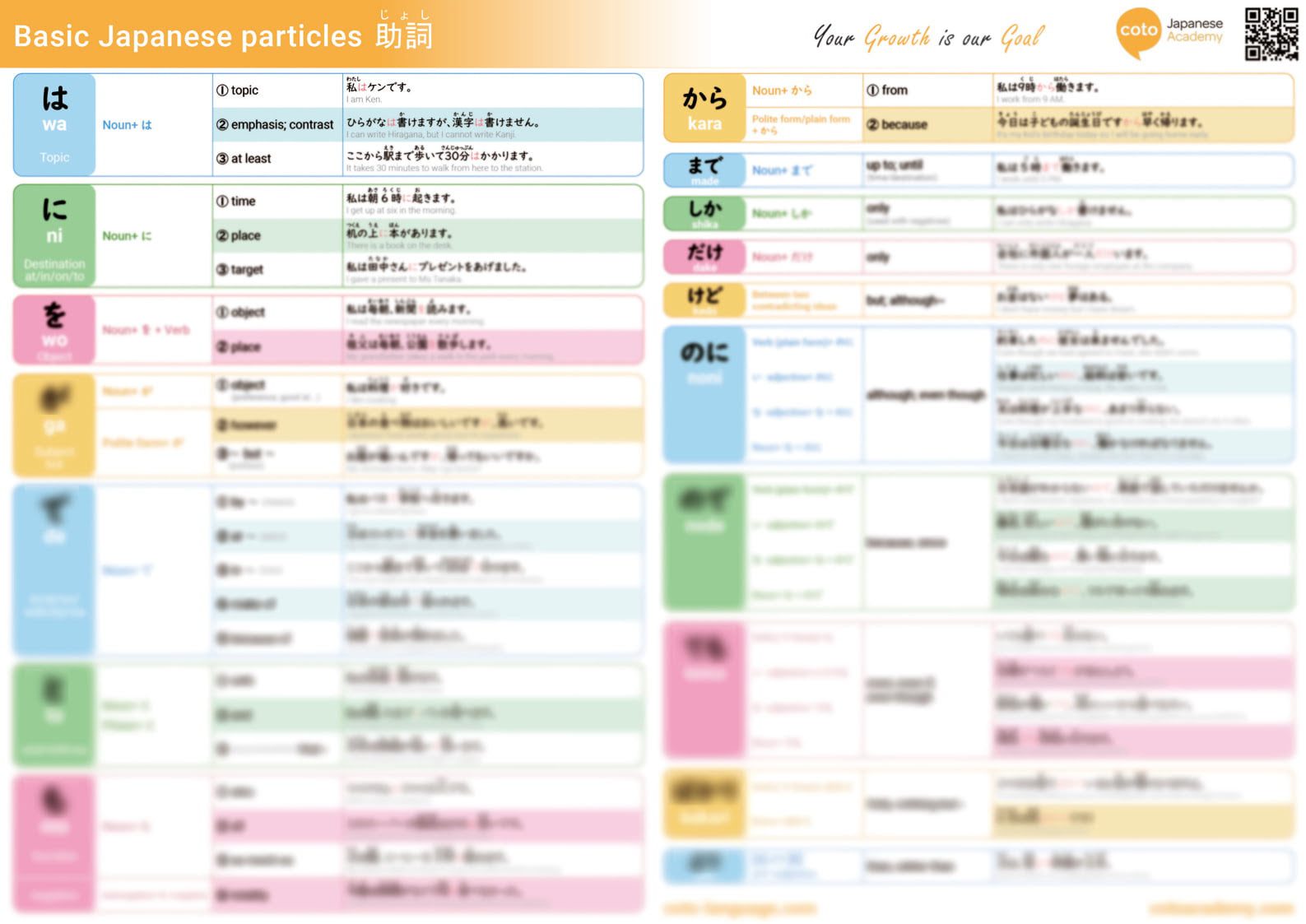Welcome to the ultimate guide to passing the JLPT N4 Exam!
The thought of taking the JLPT is stressful, but what about preparing for it? With so many things to learn, it’s easy for anyone to feel completely disorganized. In this blog, we will cover everything you need to know about the JLPT N4 Exam (test contents, length, scoring methods, etc.), how to register, how to prepare, what happens on test day, and some resources and lessons we offer at Coto Academy to help you through your studies.
Study the JLPT Smarter with Coto Academy!
Getting ready for the JLPT? Boost your chances of passing with Coto Academy’s JLPT Prep Course. We offer two flexible options: a year-round course for steady progress, and an intensive 3-month sprint course timed perfectly before test day. What makes these classes stand out are the teachers—experts in JLPT strategies—who share insider tips and techniques you simply won’t get from self-study. It covers exam practices and explanations of essentials such as Japanese grammar, vocabulary, kanji, and more!
1. About the JLPT
What is the JLPT?
JLPT stands for Japanese-Language Proficiency Test, also known as 日本語能力試験. As the name suggests, the exam measures and certifies the Japanese proficiency of non-native Japanese speakers and is used by universities and employees inside and outside Japan. It is normally carried out twice a year in Japan and available in certain other countries. JLPT Exams are often taken by Japanese learners who are planning a future in Japan!
What are the different levels of the JLPT?
The JLPT is divided into five levels: N1, N2, N3, N4, and N5, with N1 being the most advanced level and N5 being the most basic.
- The N4 and N5 test you on basic Japanese that you can often learn in a classroom environment
- The N3 acts as a bridge between N4/N5 and N2/N1
- The N2 and N1 test you on a wider spectrum of Japanese knowledge used in various situations in everyday life
Who should take the JLPT? What are the advantages of taking the N4?
If you are looking for a job or planning to pursue education in Japan, your JLPT scores will be useful. JLPT certifications can also be advantageous when immigrating to Japan, as those who have passed the N2 and N1 qualify for preferential treatment.
However, JLPT is only really useful for employment or immigration when you have passed the N2 or N1. This guide focuses on JLPT N4, which does not have much real-life use other than to check your personal improvement and prove your interest in the Japanese language.
Still, the JLPT N4 Exam can be a fitting goal for Japanese learners wanting to test their comprehension skills and basic Japanese knowledge. By taking the N4 Exam, you may be able to discover your strengths and weaknesses and pursue your studies more efficiently after that. In addition, an N4 certification can prove your mastery of basic Japanese and prepare you for the more difficult stuff covered in higher JLPT levels.
2. About the JLPT N4 Exam
What does the N4 Exam test on?
The JLPT N4 Exam is an exam for upper beginners. Generally, the JLPT N4 tests you on the understanding of the core basics of Japanese, including your ability to read and comprehend passages on daily topics written in basic Japanese vocabulary and kanji. You also need to be able to listen and follow slow-spoken conversations in daily life situations. Vocabulary and expressions used in the N4 are slightly more advanced and complex compared to those featured in the N5. Like the N5, questions on the N4 are generally straightforward.
For more information on the JLPT N5 Exam, click here.
What are the different sections of the N4 Exam?
The JLPT N4 Exam consists of three main sections. Each of the three sections tests you on different aspects of the Japanese language.
| Section | Question types |
| 1. Language Knowledge (Vocabulary) | – Kanji reading – Orthography – Contextually-defined expressions – Paraphrases – Usage |
| 2. Language Knowledge (Grammar) and Reading | – Sentential grammar 1 (selecting grammar form) – Sentential grammar 2 (sentence composition) – Text grammar – Comprehension (short passages) – Comprehension (mid-length passages) |
| 3. Listening | – Task-based comprehension – Comprehension of key points – Verbal expressions – Quick response |
What is and is not covered in the JLPT N4 Exam?
For all of the above three sections, you must master approximately 1500 vocabulary words and 300 kanji. This is 200 more kanji and 700 more vocabulary words compared to what you must know for the N5. The 1500 vocabulary words covered in the N4 Exam include basic nouns and verbs, as well as commonly used expressions, adjectives, adverbs, and some katakana words. In addition to the 100 N5 kanji that are naturally used in simple daily conversations (such as those related to numbers, time and days of the week, family members, and basic verbs), the N4 will cover kanji that are used in a wider variety of places such as restaurants and workplace. Once you’ve mastered the 300 N4 kanji, you may still have a difficult time reading native-level Japanese passages, but you will be able to survive in common situations.
Furthermore, you must be familiar with typical grammar points such as basic particle usage and formal and casual conjugations of verbs and adjectives for past and present tenses. Before taking the test, you should be comfortable with reading and writing simple sentences and expressing opinions.
Because the JLPT Exam does not test on speaking, Japanese learners who are not comfortable speaking in Japanese can theoretically still pass, as long as they have mastered the vocabulary, kanji, and grammar covered on the N4 Exam. (However, you must keep in mind that Japanese speaking and conversational abilities are still necessary for life if you are seriously considering a future in Japan!)
How long is the N4 Exam?
You are given different amounts of time for each of the three different test sections.
| Section | Time |
| Language Knowledge (Vocabulary) | 25 minutes |
| Language Knowledge (Grammar) and Reading | 55 minutes |
| Listening | 35 minutes |
| Total Time | 95 minutes |
In total, you are given 95 minutes to complete the JLPT N4 Exam.
What is the scoring for the JLPT N4 like?
Although the N4 Exam contains three sections, the scoring is divided into two.
| Section | Range of Scores |
| Language Knowledge (Vocabulary/Grammar) and Reading | 0 – 120 |
| Listening | 0 – 60 |
| Overall Score | 0 – 180 |
Your overall score can range from anywhere between 0 to 180.
For the N4 Exam, a passing score is anything above an overall score of 90 points. However, in addition to meeting the overall score of 90 points, you must also meet sectional pass marks of 38 points in the Language Knowledge (Vocabulary/Grammar) and Reading Section and 19 points in the Listening Section. This means that even if your overall score is above 90 points, if you do not have meet the sectional pass marks for both of the sections, you cannot pass. Thus, it is important to balance out your knowledge and avoid relying on one section for points.
For how long should I study to pass the N4?

For students with kanji knowledge, it takes 550 hours. That is the same as studying to improve your TOEIC score from 500 to 700.
For other students. It takes about 787 hours of studying to pass the N4. With this time, you can become a train driver in Japan.
For more information on necessary study hours for all levels of the JLPT, check out this blog article How Many Hours Does it Take to Pass the JLPT – Illustrated Guide.
3. How to Prepare
Mastering Kanji and Vocabulary
As previously mentioned, the JLPT N4 Exam covers around 300 kanji. (Of course, you do not have to know all of them to pass, but it’s impossible to predict which ones will be on the exam.)
We highly recommend you check out our JLPT N4 Kanji Self-Study Course (¥1,000) to learn the necessary N4 kanji.

This course covers N4 kanji and contains a quiz for each kanji, a downloadable pdf workbook, and a printable cheat sheet.
Additionally, you can check out our JLPT N4 Kanji Writing Workbook (¥500).

This is a downloadable and printable E-book aimed to help you practice writing N4-level kanji and memorize them efficiently.
We have also provided samples of the worksheets free of charge at the below links! These are very useful as they cover many of the kanji that you will be tested on during the N4 exam.
- Unit 1. JLPT N4 Kanji – Family
- Unit 2. JLPT N4 Kanji – Weather, Nature, Animal
- Unit 3. JLPT N4 Kanji – Hobby
As you move on from N5-level kanji to N4-level, it becomes important to learn about kanji radicals and know the meanings of individual parts of kanji. This will help you memorize each kanji more productively and recognize definitions of words better. When studying N4 kanji, we recommend you to study parts of each kanji as well.
Mastering Grammar

Although the JLPT N4 Exam scores vocabulary and grammar cumulatively, it is recommended that you study for them independently. The grammar section of the exam tests on basic particle usage (ha, ni, wo, etc.) and formal and casual conjugations of verbs and adjectives for past and present tenses.
To learn grammar points covered on the N4 Exam, you can check out the below articles on basic Japanese Grammar for free:
- Basic Japanese Grammar Guide Part I – Basic Sentence Patterns
- Basic Japanese Grammar Guide Part II – Particles (wa, ga, o, ni, de)
- Basic Japanese Grammar Guide Part III – Particles (no, to, mo, kara, made, ga)
- Basic Japanese Grammar Guide Part IV – Verbs
- 20 Must-Know Grammar Points for the JLPT N4
We have also prepared for you a free, downloadable Japanese Particles Cheat Sheet & Guide.
Our YouTube Channel is also great for learning important N4 grammar points, as well as improving your Japanese listening skills. We offer useful videos on phrases and grammar points commonly featured on the JLPT N4 and include familiar examples to help you get a grasp of how they are often used in daily life.
Here’s an example of our grammar videos:
If you are a person who learns better through videos and audio, check out our JLPT N4 Playlist, which has compiled all of the N4 grammar videos for you.
Coto also offers a FREE JLPT N4 YouTube Video Grammar Course, which includes short quizzes testing you on each of the YouTube grammar videos. This free self-study course will help you understand the contents of the videos more clearly by testing and checking your understanding of the meaning and uses of every grammar point.
If you prefer to work with textbooks and worksheets, we recommend another self-study course! Our JLPT N4 Grammar Self-Study Course (¥1,000) is a 16-week course that you complete all on your own.

This course includes 68 lessons and 67 quizzes on grammar points that will be featured on the JLPT N4 Exam. Upon purchase, you will also receive a link to download our JLPT N4 Grammar PDF Workbook.
The JLPT N4 Grammar Workbook can also be purchased independently for ¥1,300.

This workbook includes all 48 grammar points you need to pass the JLPT N4. Each grammar point has short explanations in English and in Japanese. The workbook includes practice exercises that you can do on your own!
Although self-studying is a great way to study at your own pace, textbooks and worksheets may not perfectly prepare you for what’s to come on the JLPT Exam.
We recommend enrolling in offline or online courses at Coto to more efficiently study for the N4.
4. Offline/Online Courses Offered at Coto

In addition to the resources mentioned above, Coto Academy offers offline and online classes to help you through your studies. (Offline classes are offered at our schools in Tokyo and Yokohama.)
Here is a list of lessons available at the JLPT N4 level. Click on your course of interest to learn more about the contents, price, and course schedule.
Coto Academy provides JLPT prep courses to help you ace your following JLPT exams; check the course information here and learn with us today!
Offline Courses (Tokyo/Yokohama)
- Intensive Courses
- Beginner Level 4-5-6 – a 12-week upper beginner course, perfect for students who want to start broadening their conversational Japanese. You will learn to express yourself with more complex phrases.
- Intermediate Level 1-2 – an 8-week transition course to the intermediate level. You will review previously learned expressions so that you can hold more “natural” conversations in Japanese. The course meets every weekday for 3 hours.
- Part-time Lessons
- Effective Drill Training – aimed to help students improve their quick-response ability and build their confidence. You will use a series of specially designed drills and speaking training to improve your communication ability.
- Conversation Level-up – focused on developing your ability to convey your wishes, ask for permission while giving a reason, study assumptive expressions, and express your feelings or things that happened more accurately.
- Essential Grammar and Conversation – a part-time class dedicated to helping you practice making conversations about a variety of topics. You will improve your vocabulary and ability to converse smoothly throughout this course.
- Bridge to Intermediate – serves as a “Bridge” to the intermediate level. The course focuses on the core basic sentence patterns, improving vocabulary for a variety of daily situations, and building more complex sentences.
- Private Lessons – matched to our students’ Japanese study experience and comprehension, and needs 1-1 with a professional teacher. Instead of in small groups, you will privately meet a professional instructor and receive a lesson plan strictly designed to fit your needs and studying habits. Perfect for those wanting flexible scheduling to tackle their language weaknesses proactively.
Online Courses
- Private Lessons – matched to our students’ Japanese study experience, comprehension, and needs 1-1 with a professional teacher online. Instead of in small groups, you will meet privately with a professional instructor online via Zoom and receive a lesson plan strictly designed to fit your needs and studying habits. Perfect for those wanting flexible scheduling to tackle their language weaknesses proactively.
- Group Lessons
- Essential Grammar & Conversation – an online part-time class dedicated to helping you practice making conversations about a variety of topics. You will improve your vocabulary and ability to converse smoothly throughout this course.
- Bridge to Intermediate – serves as a “Bridge” to the intermediate level. The course focuses on the core basic sentence patterns, improving vocabulary for a variety of daily situations, and building more complex sentences.
- Lite Intensive (Beginner 4) – an upper-beginner intensive course that uses the Genki textbook series and will cover ways to construct natural conversations. By the end of this course, you will be able to have more natural conversations and make long sentences.
- JLPT N4 Online Prep Lecture – designed for students wanting to study individually with the lesson material while listening to the lecture on the screen. It is an affordable and convenient option for those seeking a high-quality seminar-style classroom taught by a professional native. We utilize our in-house exercises and study materials specialized for JLPT preparation in this lecture. You will be assigned materials each week on Google Classroom.
To sign up for and enroll in classes, visit this page and you will be directed to schedule a free interview!
5. How to Register
Next Test Date: December 1st 2024
Application Period: Until September 12 (Thu), 17:00
Application Method: You must apply from the MyJLPT “JLPT Application” screen after registering with MyJLPT on the JLPT website of Japan Educational Exchanges and Services (JESS).
Test Fee: 7,500 yen (consumption tax included)
Payment Methods: Credit card, bank wire transfer (pay-easy), payment at a convenience store
Once registered, you will receive a test voucher around mid-November indicating your test location and more details about the JLPT Exam.
For more information, visit the JLPT Official Website.
6. What Happens on Test Day
It’s your big test day!
Before heading out to your test center, bring your test voucher, writing utensils (mechanical pencils are accepted), and maybe some snacks and a watch to help you with time management.
For examinees in Japan, your test will begin at 12:30, but the test center will be open from 11:45. We recommend you head out early to be safe.
Once you arrive at your test venue, you will be asked to show your test voucher to the staff. Examinees are split into different rooms based on their voucher numbers. You will be instructed to enter one of these rooms.
You will find the desk with your number once you have found and entered your room. You will receive instructions from staff and begin your exam when it’s time.
The whole exam will take several hours (in the case of the N4 Exam, 95 minutes), and you will get short breaks between each section. When the exam is finished, you must wait until all test papers have been collected before leaving the room.
*Processes at overseas testing sites may differ.
Check out our guides for other JLPT levels as well:

